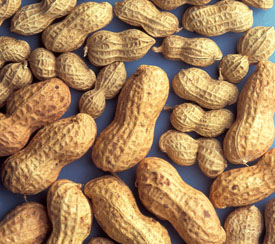Peanuts
Peanuts (Arachis hypogaea), also referred to as groundpeas or groundnuts, are an annual herbaceous legume with an indeterminate growth habit. As these alternate names imply, this unique plant produces its fruit (peanut) below ground. Once the small yellow flowers are self-pollinated, the fertilized ovary elongates into a “peg,” which grows downward and penetrates into the soil. Peanuts develop underground at the ends of the pegs. The peanut seed is referred to as a kernel and the outer shell is called a pod or hull.
Marketing
 Peanuts can be grown for the dry market, in which case they are dried and processed into shelled or unshelled roasted nuts, peanut butter, candy, and other food products. Small growers, such as those who are likely to investigate peanut production in Kentucky, may choose to process their own peanuts to sell at a number of local markets. Freshly roasted nuts could be sold at farmers markets, fairs, roadside markets, or even provided at sporting events or to catering services. Unprocessed green (freshly dug, not dried) and raw (freshly dug, somewhat dried) peanuts can be marketed for boiled peanuts, a popular Southern snack. These fresh market peanuts may be sold for consumers to boil or marketed already boiled. Market options for freshly dug peanuts include farmers markets and other direct markets, as well as local grocery stores. Fresh peanuts are more perishable than dry peanuts and are often sold by volume (bushel) instead of weight.
Peanuts can be grown for the dry market, in which case they are dried and processed into shelled or unshelled roasted nuts, peanut butter, candy, and other food products. Small growers, such as those who are likely to investigate peanut production in Kentucky, may choose to process their own peanuts to sell at a number of local markets. Freshly roasted nuts could be sold at farmers markets, fairs, roadside markets, or even provided at sporting events or to catering services. Unprocessed green (freshly dug, not dried) and raw (freshly dug, somewhat dried) peanuts can be marketed for boiled peanuts, a popular Southern snack. These fresh market peanuts may be sold for consumers to boil or marketed already boiled. Market options for freshly dug peanuts include farmers markets and other direct markets, as well as local grocery stores. Fresh peanuts are more perishable than dry peanuts and are often sold by volume (bushel) instead of weight.
Production
 There are four types of peanuts grown in the U.S.: runner, Valencia, Virginia, and Spanish. Of these, early maturing cultivars of the Valencia and Spanish types may be best suited for the Kentucky growing season and markets. Peanuts grow best on a light-colored, loose, friable soil with good drainage. Nuts grown in sandy loam soils will have brighter appearing hulls with less staining compared to nuts grown in clay soils. This crop should not be planted in the same site more than one year out of three or four. Peanuts do well after perennial grasses, corn, grain sorghum, and small grains, but should not be planted following other legumes, such as soybeans or forage legumes. Seeds are planted after danger of frost has passed and soils have warmed sufficiently. Peanuts can be grown in single or twin rows using conventional or strip tillage practices. Strip tillage offers the advantages of moisture conservation and less soil erosion along with a reduction in time and cost for land preparation.
There are four types of peanuts grown in the U.S.: runner, Valencia, Virginia, and Spanish. Of these, early maturing cultivars of the Valencia and Spanish types may be best suited for the Kentucky growing season and markets. Peanuts grow best on a light-colored, loose, friable soil with good drainage. Nuts grown in sandy loam soils will have brighter appearing hulls with less staining compared to nuts grown in clay soils. This crop should not be planted in the same site more than one year out of three or four. Peanuts do well after perennial grasses, corn, grain sorghum, and small grains, but should not be planted following other legumes, such as soybeans or forage legumes. Seeds are planted after danger of frost has passed and soils have warmed sufficiently. Peanuts can be grown in single or twin rows using conventional or strip tillage practices. Strip tillage offers the advantages of moisture conservation and less soil erosion along with a reduction in time and cost for land preparation.

